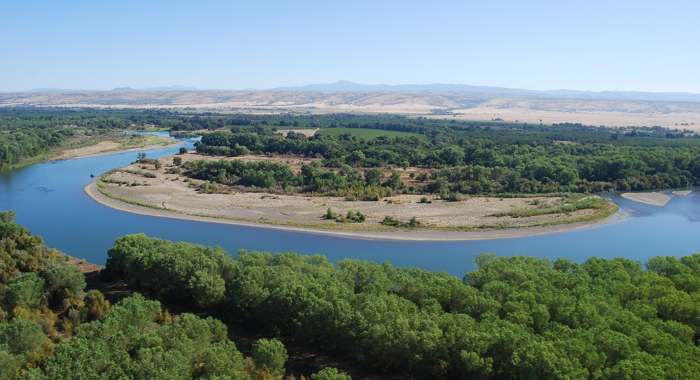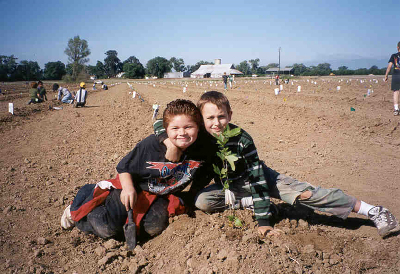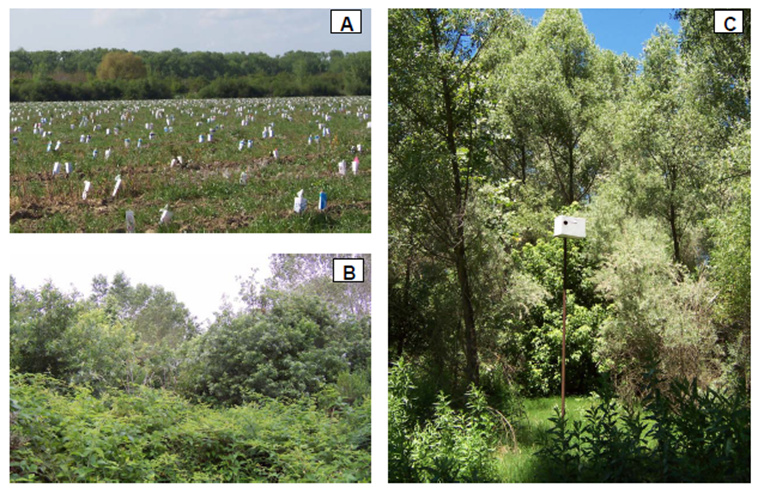How can we restore large rivers and floodplains to benefit nature and people?

Aerial view of the Sacramento River. In the foreground is 15-year-old restored riparian habitat that is now part of the USFWS Sacramento River National Wildlife Refuge. Photo: © Rich Reiner | TNC
The Sacramento River is the most important river in California for both people and nature. It stretches 384 miles, and drains the inland slopes of the Klamath Mountains, the Cascade Range, the Coast Ranges and the northern Sierra Nevada. The river supplies 35% of the state’s developed water supply, and contains critical habitats for a multitude of commercially and ecologically important species.

School children from Gerber helping with riparian restoration planting along the Sacramento River. Photo: © TNC
Although still vitally important, today’s Sacramento River is highly degraded relative to its former condition. Fish and bird populations have plummeted as 90% of the river’s forests have been cleared and water has been diverted for agriculture and municipal uses. The once meandering river is no longer free to carve its own path across the valley floor, creating the habitats that native species evolved to depend upon. In many places, the river is locked in place by riprap (rocks or other materials that armor shorelines), and levees, which disconnect it from its historic floodplain.
The Nature Conservancy is working to restore the river’s ecosystem and enhance the natural services that the river provides to people, including flood protection, water quality, and recreation.
Nature Conservancy scientists have advanced restoration of the Sacramento River by demonstrating both the ecological benefits and the societal gains that result from healthy riverine ecosystems. These scientific advances have helped us overcome initial opposition to river restoration. Specifically, our studies:

Sacramento River riparian restoration sites of varying ages. A) Newly planted restoration site, B) Six-year old restoration site, and C) Fifteen-year old site. Photo: © Greg Golet
By sharing the results of our studies with local stakeholders, river managers, and the scientific community, the Conservancy gained the support needed to restore over 6,000 acres of floodplain habitat in what has become one of the largest and most successful river restoration projects in the United States.
Golet G.H., Kristen E. Dybala, Joeseph G. Silvera, Adam Henderson, Jennifer Isola, David H. Wright, Ron Melcer Jr., and Danika Tsao.
Lowland alluvial rivers are rich in biodiversity, yet many are highly degraded and no longer support robust natural communities. Over the past few decades, Bank Swallows, which depend upon these…John C. Stella, Li Kui, Gregory H. Golet, Frank Poulsen
Streamside forests are incredibly important for fish, birds and other wildlife. They are also valuable for storing carbon which is needed to combat climate change. This is especially the case in…Case study by: K.D. Holl, G.H. Golet
Advancing conservation requires understanding the constraints imposed on natural systems by human societies. This understanding typically comes from engagement with local stakeholders, as opposed…Kristen E. Dybala, Neil Clipperton, Thomas Gardali, Gregory H. Golet, Rodd Kelsey, Stefan Lorenzato, Ron Melcer, Jr., Nathaniel E. Seavy, Joseph G. Silveira
The Conservancy and partners are working to establish riparian ecosystems that provide sufficient habitat to support genetically robust, self-sustaining, and resilient bird populations in…Cara Byington, Greg Golet
Matthew G. Johnson, Kylene Lang, Paul Manos, Greg H. Golet, Kristina A. Schierenbeck
When non-native ornamental species spread into wild landscapes they can displace natives that have greater wildlife habitat value. Controlling the spread of a non-native species can be difficult when…Vasilissa V. Derugin, Joseph G. Silveira, Gregory H. Golet, Gretchen LeBuhn
In restoration ecology, understanding how and when species colonize newly created habitat is critically important for assessing progress toward restoration goals. By using camera traps to take a…Golet G.H., D.L. Brown, M. Carlson, T. Gardali, A. Henderson, K.D. Holl, C.A. Howell, M. Holyoak, J. Hunt, G.M. Kondolf, E.W. Larsen, R.A. Luster, C. McClain, C. Nelson, S. Paine, W. Rainey, Z. Rubin, F. Shilling, J.G. Silveira, H. Swagerty, N.M. Williams, D.M. Wood
Large-scale ecosystem restoration projects seldom undergo comprehensive evaluation to determine project effectiveness. Consequently, there are missed opportunities for learning and strategy…Golet G.H., J. Hunt, D. Koenig
Floodplains often are managed both for agriculture and as habitat for native species. On the Sacramento River, farmers have expressed concern that natural areas may be sources of pests to adjoining…G.H. Golet, T. Gardali, J.W. Hunt, D.A. Koenig, N.M. Williams
Most assessments of ecological restoration success track a single type of species over a single season. This study explores the limitations of such studies by examining how birds, rodents, bees…Golet G.H., T. Gardali, C. Howell, J. Hunt, R. Luster, B. Rainey, M. Roberts, H. Swagerty, N. Williams
Studies that assess the success of riparian restoration projects seldom focus on wildlife. More often, vegetation is studied, with the assumption that animal populations will recover once adequate…Gardali T. , A.L. Holmes, S.L. Small, N. Nur, G.R. Geupel, G.H. Golet
Restoration efforts on the Sacramento River are focusing on revegetating the land with native plants and restoring natural river processes in an attempt to recover wildlife populations. To evaluate…Golet G.H., M.D. Roberts , E.W. Larsen, R.A. Luster, R. Unger, G. Werner, G.G. White.
River restoration projects have the potential to influence many of the services that rivers provide to people, yet rarely is this studied in a comprehensive manner. This paper reports on a set of…